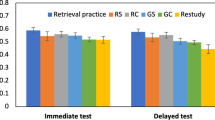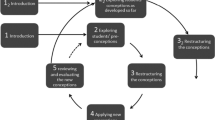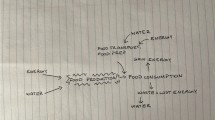Abstract
Drawing, constructing, and explaining a model of a given abstract phenomenon is a challenging task. In this study, students were engaged in the Project-Based Inquiry Science (PBIS)-Air Quality learning unit, as part of their chemistry curriculum. The study aim is to determine how well students understand chemistry conceptually after completing the PBIS Air-Quality learning unit. Using their pre- and post-closed-ended questions as well as their post-drawing assignment, we developed a rubric to examine students’ conceptual understanding as manifested in their drawings and examined if there is a correlation between their drawings and their pre- and post-questionnaire results. Research participants were 436 eighth-grade middle school students. The results suggest that state of matter and distance between molecules were conceptually understood better after learning the PBIS unit. We analyzed students’ explanations and drawings based on the rubric and found a moderate positive correlation between students’ post-scores in the questionnaires and their answer complexity level in the post drawing assignment. The research shows that students’ conceptual understanding should be assessed through different assessment methods to gain a better evaluation of students’ conceptual understanding. Even students who succeeded in the close-ended questions in the post-questionnaire had difficulties expressing their conceptual understanding through the drawing assignment. The rubric can help teachers and educators assess their students’ conceptual models and can be used as an assessment tool to evaluate the progression of their chemistry understanding. Teaching with rubrics will improve the quality of assessment and facilitate teachers’ development.












Similar content being viewed by others
Data availability
The original data can not be shared due to ethical considerations.
References
Ainsworth, S., Prain, V., & Tytler, R. (2011). Drawing to learn in science. Science, 333(6046), 1096–1097. https://doi.org/10.1126/science.1204153
Akaygun, S. (2016). Is the oxygen atom static or dynamic? The effect of generating animations on students’ mental models of atomic structure. Chemistry Education Research and Practice, 17(4), 788–807. https://doi.org/10.1039/c6rp00067c
Akiha, K., Brigham, E., Couch, B. A., Lewin, J., Stains, M., Stetzer, M. R., Vinson, E. L., & Smith, M. K. (2018). What types of instructional shifts do students experience? Investigating active learning in science, technology, engineering, and math classes across key transition points from middle school to the university level. Frontiers in Education, 2. https://doi.org/10.3389/feduc.2017.00068
Avargil, S., & Piorko, R. (2022). High school students’ understanding of molecular representations in a context-based chemistry learning environment. International Journal of Science Education, 44(11), 1738–1766. https://doi.org/10.1080/09500693.2022.2095679
Avargil, S., Bruce, M., Francois A., & Bruce, A. (2015). Students’ understanding of analogy in a CORE (Chemical Observations, Representations, Experimentation) learning cycle, general chemistry experiment. Journal of Chemical Education, 92(10), 1626–1638. https://doi.org/10.1021/acs.jchemed.5b00230
Barak, M., Yachin, T., & Erduran, S. (2022). Tracing preservice teachers’ understanding of nature of science through their drawings and writing. Research in Science Education. https://doi.org/10.1007/s11165-022-10069-3
Barak, M. (2017). Reflective drawings as means for depicting icts roles in science and engineering learning in the 21st century. In Drawing for Science Education: An International Perspective (pp. 31–40). Brill. https://doi.org/10.1007/978-94-6300-875-4_3
Baumfalk, B., Bhattacharya, D., Vo, T., Forbes, C., Zangori, L., & Schwarz, C. (2019). Impact of model-based science curriculum and instruction on elementary students’ explanations for the hydrosphere. Journal of Research in Science Teaching, 56(5), 570–597. https://doi.org/10.1002/tea.21514
Berland, L. K., Schwarz, C. V., Krist, C., Kenyon, L., Lo, A. S., & Reiser, B. J. (2016). Epistemologies in practice: Making scientific practices meaningful for students. Journal of Research in Science Teaching, 53(7), 1082–1112. https://doi.org/10.1002/tea.21257
Bruce, M .R. M., Bruce, A. E., Avargil, S., Amar, F. G., Wemyss, T., & Flood, V. J. (2016). Polymers and cross-linking: a CORE experiment to help students think on the atomic scale. Journal of Chemical Education, 93(9), 1599–1605. https://doi.org/10.1021/acs.jchemed.6b00010
Chang, H. Y., Quintana, C., & Krajcik, J. S. (2010). The impact of designing and evaluating molecular animations on how well middle school students understand the particulate nature of matter. Science Education, 94(1), 73–94. https://doi.org/10.1002/sce.20352
Chang, H. Y., Lin, T. J., Lee, M. H., Lee, S. W. Y., Lin, T. C., Tan, A. L., & Tsai, C. C. (2020). A systematic review of trends and findings in research employing drawing assessment in science education. In Studies in Science Education, 56(1), 77–110. https://doi.org/10.1080/03057267.2020.1735822
Cheng, M. M. W., & Gilbert, J. K. (2017). Modelling students’ visualisation of chemical reaction. International Journal of Science Education, 39(9), 1173–1193. https://doi.org/10.1080/09500693.2017.1319989
Chiu, M.-H., & Lin, J.-W. (2019). Modeling competence in science education. Disciplinary and Interdisciplinary Science Education Research, 1(1). https://doi.org/10.1186/s43031-019-0012-y
Clement, J., & Rea-Ramirez, M. A. (2008). Model based learning and instruction in science. In Model based learning and instruction in science. Springer. https://doi.org/10.1007/978-1-4020-6494-4
Crawford, B., & Cullin, M. (2005). Dynamic assessments of preservice teachers’ knowledge of models and modelling. Research and the Quality of Science Education, 309–323. https://doi.org/10.1007/1-4020-3673-6_25
Creswell, J. W., Plano Clark, V. L., Gutmann, M. L., & Hanson, W. E. (2003). An expanded typology for classifying mixed methods research into designs. In Tashakkori, A. & Teddlie, C. (Eds.), Advanced mixed methods research designs (pp. 159–196). SAGE Publications Sage CA: Thousand Oaks, CA.
Creswell, J. W., Hanson, W. E., Clark Plano, V. L., & Morales, A. (2007). Qualitative research designs: Selection and implementation. The Counseling Psychologist, 35(2), 236–264. https://doi.org/10.1177/0011000006287390
Creswell, J. W. (2014). Research design: Qualitative, quantitative, and mixed methods approaches (4th ed.). Sage Publications, Inc.
Dangur, V., Avargil, S., Peskin, U., & Dori, Y. J. (2014). Learning quantum chemistry via a visual-conceptual approach: Students’ bidirectional textual and visual understanding. In Chemistry Education Research and Practice, 15(3), 297–310. https://doi.org/10.1039/c4rp00025k
Deboer, G. E., Herrmann-abell, C. F., Wertheim, J., & Roseman, J. E. (2009). Assessment linked to middle school science learning goals: A report on field test results for four middle school science topics. 1–32. https://www.researchgate.net/publication/237533442
DiSessa, A. A., Hammer, D., Sherin, B. L., & Kolpakowski, T. (1991). Inventing graphing: meta-representational expertise in children. Journal of Mathematical Behavior, 10, 117–160.
Dori, Y. J., & Hameiri, M. (2003). Multidimensional analysis system for quantitative chemistry problems: Symbol, macro, micro, and process aspects. Journal of Research in Science Teaching, 40(3), 278–302. https://doi.org/10.1002/tea.10077
Dori, Y. J., Avargil, S., Kohen, Z., & Saar, L. (2018). Context-based learning and metacognitive prompts for enhancing scientific text comprehension. International Journal of Science Education, 40(10), 1198–1220. https://doi.org/10.1080/09500693.2018.1470351
Dukerich, L. (2015). Applying modeling instruction to high school chemistry to improve students’ conceptual understanding. Journal of Chemical Education, 92(8), 1315–1319. https://doi.org/10.1021/ed500909w
Finkenstaedt-Quinn, S. A., Halim, A. S., Kasner, G., Wilhelm, C. A., Moon, A., Gere, A. R., & Shultz, G. V. (2020). Capturing student conceptions of thermodynamics and kinetics using writing. Chemistry Education Research and Practice, 21(3), 922–939. https://doi.org/10.1039/c9rp00292h
Fiorella, L., & Zhang, Q. (2018). Drawing boundary conditions for learning by drawing. Educational Psychology Review, 30(3), 1115–1137. https://doi.org/10.1007/s10648-018-9444-8
Friedman, S., Forbus, K., & Sherin, B. (2018). Representing, running, and revising mental models: A computational model. Cognitive Science, 42(4), 1110–1145. https://doi.org/10.1111/cogs.12574
Garrison, D. R., Cleveland-Innes, M., Koole, M., & Kappelman, J. (2006). Revisiting methodological issues in transcript analysis: Negotiated coding and reliability. Internet and Higher Education, 9(1), 1–8. https://doi.org/10.1016/j.iheduc.2005.11.001
Gilbert, J.K., & Justi, R. (2016). Modeling-based teaching in science education. Cham: Springer Nature.
Göhner, M. F., Bielik, T., & Krell, M. (2022). Investigating the dimensions of modeling competence among preservice science teachers: Meta-modeling knowledge, modeling practice, and modeling product. Journal of Research in Science Teaching, in Press. https://doi.org/10.1002/tea.21759
Gray, K. E., Wittmann, M. C., Vokos, S., & Scherr, R. E. (2019). Drawings of energy: Evidence of the Next Generation Science Standards model of energy in diagrams. Physical Review Physics Education Research, 15(1), 10129. https://doi.org/10.1103/PhysRevPhysEducRes.15.010129
Hallström, J., & Schönborn, K. J. (2019). Models and modelling for authentic STEM education: Reinforcing the argument. International Journal of STEM Education, 6(1), 1–10. https://doi.org/10.1186/S40594-019-0178-Z
Hamza, K., Wickman, P.-O., & Kelly, G. (2008). Describing and analyzing learning in action: An empirical study of the importance of misconceptions in learning science. Science Education, 92(1), 141–164. https://doi.org/10.1002/sce
Harris, C. J., Penuel, W. R., D’Angelo, C. M., DeBarger, A. H., Gallagher, L. P., Kennedy, C. A., Cheng, B. H., & Krajcik, J. S. (2015). Impact of project-based curriculum materials on student learning in science: Results of a randomized controlled trial. Journal of Research in Science Teaching, 52(10), 1362–1385. https://doi.org/10.1002/tea.21263
Herrmann-Abell, C. F., & DeBoer, G. E. (2011). Using distractor-driven standards-based multiple-choice assessments and Rasch modeling to investigate hierarchies of chemistry misconceptions and detect structural problems with individual items. Chemistry Education Research and Practice, 12(2), 184–192. https://doi.org/10.1039/c1rp90023d
Hsieh, H.-F.F., & Shannon, S. E. (2005). Three approaches to qualitative content analysis. Qualitative Health Research, 15(9), 1277–1288. https://doi.org/10.1177/1049732305276687
Inkinen, J., Klager, C., Juuti, K., Schneider, B., Salmela-Aro, K., Krajcik, J., & Lavonen, J. (2020). High school students’ situational engagement associated with scientific practices in designed science learning situations. Science Education, 104(4), 667–692. https://doi.org/10.1002/sce.21570
Jackson, J., Dukerich, L., & Hestenes, D. (2005). Modeling instruction : An effective model for science education. Science Educator, 17(1), 10–17. https://doi.org/10.1007/s10972-010-9225-9
De Jong, O., Blonder, R., & Oversby, J. (2013). How to balance chemistry education between observing phenomena and thinking in models. In I. Eilks & A. Hofstein (Eds.), Teaching Chemistry – A Studybook (pp. 97–126). Brill. https://doi.org/10.1007/978-94-6209-140-5_4
Justi, R., Gilbert, J. K., & Ferreira, P. F. M. (2009). The application of a ‘model of modelling’ to illustrate the importance of metavisualisation in respect of the three types of representation. In J. K. Gilbert & D. Treagust (Eds.), Multiple representations in chemical education (Vol. 4, pp. 285–307). Springer Netherlands. https://doi.org/10.1007/978-1-4020-8872-8
Ke, L., Sadler, T. D., Zangori, L., & Friedrichsen, P. J. (2021). Developing and using multiple models to promote scientific literacy in the context of socio-scientific issues. Science and Education, 30, 589–607. https://doi.org/10.1007/s11191-021-00206-1
Ke, L., Zangori, L. A., Sadler, T. D., & Friedrichsen, P. J. (2020). Integrating scientific modeling and socio-scientific reasoning to promote scientific literacy. In W. Powell (Ed.), Socioscientific Issues-Based Instruction for Scientific Literacy Development (pp. 31–54). IGI Global. https://doi.org/10.4018/978-1-7998-4558-4.ch002
Kite, V., Park, S., McCance, K., & Seung, E. (2021). Secondary science teachers’ understandings of the epistemic nature of science practices. Journal of Science Teacher Education, 32(3), 243–264. https://doi.org/10.1080/1046560X.2020.1808757
Kohen, Z., & Orenstein, D. (2021). Mathematical modeling of tech-related real-world problems for secondary school-level mathematics. Educational Studies in Mathematics, 107(1), 71–91. https://doi.org/10.1007/s10649-020-10020-1
Kolodner, J. L., Krajcik, J. S., Edelson, D. C., Reiser, B. J., & Starr, M. L. (2010). Project-based science inquiry: air quality. Armonk, NY: It’s About Time.
Lavi, R., Shwartz, G., & Dori, Y. J. (2019). Metacognition in chemistry education: A literature review. Israel Journal of Chemistry, 59(6), 583–597. https://doi.org/10.1002/ijch.201800087
Lazenby, K., & Becker, N. M. (2021). Evaluation of the students’ understanding of models in science (SUMS) for use in undergraduate chemistry. Chemistry Education Research and Practice, 22(1), 12–29. https://doi.org/10.1039/d0rp00084a
Lazenby, K., Stricker, A., Brandriet, A., Rupp, C. A., Mauger-Sonnek, K., & Becker, N. M. (2020). Mapping undergraduate chemistry students’ epistemic ideas about models and modeling. Journal of Research in Science Teaching, 57(5), 794–824. https://doi.org/10.1002/tea.21614
Locatelli, S. W., & Davidowitz, B. (2021). Using metavisualization to revise an explanatory model regarding a chemical reaction between ions. Chemistry Education Research and Practice, 22(2), 382–395. https://doi.org/10.1039/d0rp00339e
Marchak, D., Shvarts-Serebro, I., & Blonder, R. (2021). Crafting molecular geometries: Implications of neuro-pedagogy for teaching chemical content. Cite This: Journal of Chemical Education, 98, 1321–1327. https://doi.org/10.1021/acs.jchemed.0c00306
National Research Council. (2012). A framework for K-12 science education: Practices, crosscutting concepts, and core ideas. National Academies Press.
Oh, P. S., & Oh, S. J. (2011). What teachers of science need to know about models: An overview. International Journal of Science Education, 33(8), 1109–1130. https://doi.org/10.1080/09500693.2010.502191
Panadero, E., & Jonsson, A. (2013). The use of scoring rubrics for formative assessment purposes revisited: A review. In Educational Research Review (Vol. 9, pp. 129–144). Elsevier. https://doi.org/10.1016/j.edurev.2013.01.002
Penuel, W. R., Harris, C. J., & DeBarger, A. H. (2015). Implementing the Next Generation Science Standards. Phi Delta Kappan, 96(6), 45–49. https://doi.org/10.1177/0031721715575299/FORMAT/EPUB
Reid, N. (2021). Advances in chemistry education series (N. Reid (ed.)). Royal Society of Chemistry. https://doi.org/10.1039/9781839163661-00048
Rery, R., Copriady, J., Alimin, M., & Wilda Albeta, S. (2020). Analysis of science motivation based on learning of conventional, realistic and hybrid image in chemistry. Journal of Physics: Conference Series, 1655(1). https://doi.org/10.1088/1742-6596/1655/1/012041
Roche Allred, Z. D., & Bretz, S. L. (2019). University chemistry students’ interpretations of multiple representations of the helium atom. Chemistry Education Research and Practice, 20(2), 358–368. https://doi.org/10.1039/c8rp00296g
Samarapungavan, A., Bryan, L., & Wills, J. (2017). Second graders’ emerging particle models of matter in the context of learning through model-based inquiry. Journal of Research in Science Teaching, 54(8), 988–1023. https://doi.org/10.1002/tea.21394
Schwarz, C. V., & Gwekwerere, Y. N. (2007). Using a guided inquiry and modeling instructional framework (EIMA) to support preservice K-8 science teaching. Science Education, 91(1), 158–186. https://doi.org/10.1002/SCE.20177
Schwarz, C. V., Reiser, B. J., Davis, E. A., Kenyon, L., Achér, A., Fortus, D., Shwartz, Y., Hug, B., & Krajcik, J. (2009). Developing a learning progression for scientific modeling: Making scientific modeling accessible and meaningful for learners. Journal of Research in Science Teaching, 46(6), 632–654. https://doi.org/10.1002/tea.20311
Shemwell, J. T., Avargil, S., & Capps, D. K. D. K. (2015a). Grappling with long-term learning in science: A qualitative study of teachers’ views of developmentally oriented instruction. Journal of Research in Science Teaching, 52(8), 1163–1187. https://doi.org/10.1002/tea.21239
Shemwell, J. T., Gwarjanski, K. R., Capps, D. K., Avargil, S., & Meyer, J. L. (2015b). Supporting teachers to attend to generalisation in science classroom argumentation. International Journal of Science Education, 37(4). https://doi.org/10.1080/09500693.2014.1000428
Stieff, M. (2019). Improving learning outcomes in secondary chemistry with visualization-supported inquiry activities. Journal of Chemical Education. https://doi.org/10.1021/acs.jchemed.9b00205
Stieff, M., & DeSutter, D. (2021). Sketching, not representational competence, predicts improved science learning. Journal of Research in Science Teaching, 58(1), 128–156. https://doi.org/10.1002/TEA.21650
Treagust, D. F., Chittleborough, G., & Mamiala, T. L. (2003). The role of submicroscopic and symbolic representations in chemical explanations. International Journal of Science Education, 25(11), 1353–1368. https://doi.org/10.1080/0950069032000070306
Tytler, R. (2007). Re-imagining science education: Engaging students in science for Australia. Teaching Science-the Journal of the Australian Science Teachers Association, 53(4), 14–17.
Tytler, R., Prain, V., Aranda, G., Ferguson, J., & Gorur, R. (2020). Drawing to reason and learn in science. Journal of Research in Science Teaching, 57(2), 209–231. https://doi.org/10.1002/tea.21590
Vinson, E. L., Stetzer, M. R., Lewin, J. D., & Smith, M. K. (2020). The university classroom observation program: Connecting middle and high school teachers with university instructors. Journal of Higher Education Outreach and Engagement, 24(2), 37–52.
Wang, Z., Chi, S., Hu, K., & Chen, W. (2014). Chemistry teachers’ knowledge and application of models. Journal of Science Education and Technology, 23(2), 211–226. https://doi.org/10.1007/s10956-013-9455-7
Watts, F. M., & Finkenstaedt-Quinn, S. A. (2021). The current state of methods for establishing reliability in qualitative chemistry education research articles. Chemistry Education Research and Practice, 1997. https://doi.org/10.1039/d1rp00007a
Wilkerson-Jerde, M. H., Gravel, B. E., & Macrander, C. A. (2015). Exploring shifts in middle school learners’ modeling activity while generating drawings, animations, and computational simulations of molecular diffusion. Journal of Science Education and Technology, 24(2–3), 396–415. https://doi.org/10.1007/s10956-014-9497-5
Zangori, L., Vo, T., Forbes, C. T., & Schwarz, C. V. (2017). Supporting 3rd-grade students model-based explanations about groundwater: A quasi-experimental study of a curricular intervention. International Journal of Science Education, 39(11), 1421–1442. https://doi.org/10.1080/09500693.2017.1336683
Acknowledgements
We would like to thank Prof. Mitchell R. M. Bruce and Prof. François G. Amar from the Department of Chemistry at The University of Maine. We appreciate their support and comments. The second author would like to thank the Technion - Israel Institute of Technology for providing a graduate student scholarship. We would like to thank Dr. Zehavit Kohen for her comments on the statistical analysis.
Funding
This work was supported by a grant from the National Science Foundation (DRL-0962805).
Author information
Authors and Affiliations
Corresponding author
Ethics declarations
Disclaimer
Any opinions, findings, and conclusions or recommendations expressed in this material are those of the authors and do not necessarily reflect the views of the granting agency.
Ethics Approval
The research has been approved by the Institutional Review Board (IRB); record ID is 31688231. All parents signed a parental consent form, and all students signed a student assent form. The research’s digital documents are all password-protected. All the questionnaires remain in a secure location. The gathered and analyzed questionnaires have been stripped of all personal information, including student names.
Conflict of Interest
The authors declare no competing interests. Notes of Acknowledgment: We would like to thank Prof. Mitchell R. M. Bruce and Prof. François G. Amar from the Department of Chemistry at The University of Maine. We appreciate their support and comments. The second author would like to thank the Technion - Israel Institute of Technology for providing a graduate student scholarship. We would like to thank Dr. Zehavit Kohen for her comments on the statistical analysis
Additional information
Publisher's Note
Springer Nature remains neutral with regard to jurisdictional claims in published maps and institutional affiliations.
Appendix. Pre- and post- closed-ended questions
Appendix. Pre- and post- closed-ended questions

Rights and permissions
Springer Nature or its licensor (e.g. a society or other partner) holds exclusive rights to this article under a publishing agreement with the author(s) or other rightsholder(s); author self-archiving of the accepted manuscript version of this article is solely governed by the terms of such publishing agreement and applicable law.
About this article
Cite this article
Avargil, S., Saxena, A. Students’ Drawings, Conceptual Models, and Chemistry Understanding in the Air-Quality Learning Unit. Res Sci Educ 53, 841–865 (2023). https://doi.org/10.1007/s11165-023-10107-8
Accepted:
Published:
Issue Date:
DOI: https://doi.org/10.1007/s11165-023-10107-8




